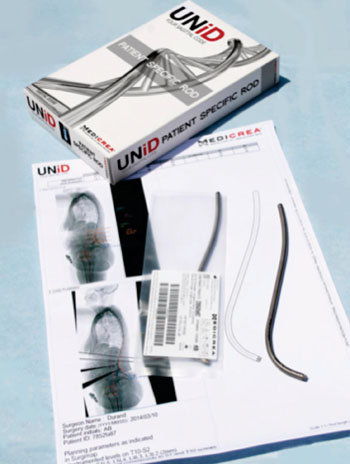Patient-Specific Rod Simplifies Spinal Surgery
By HospiMedica International staff writers
Posted on 25 Nov 2014
An innovative customized spinal osteosynthesis rod offers numerous benefits to surgeons and patients undergoing spine surgery.Posted on 25 Nov 2014
The UNiD patient-specific spinal rod is pre-contoured and customized for each patient, using a controllable and reproducible industrial process that eliminates the intraoperative use of a bending device. A user-friendly software tool helps surgeons preoperatively plan and order the customized, rods to fit the specific spinal alignment with a precisely aligned rod prior to surgery, reducing the amount of time patients spend in the operating room, which also directly impacts infection rate and quality of recovery.

Image: A UNiD patient-specific spinal rod (Photo courtesy of Medicrea).
The rod is fabricated using the services of the UNiD Lab, which processes the request and industrially produces and labels the rod specifically for the patient. To initiate the process, the surgeon first analyzes, designs, and orders the patient-specific rod using a proprietary plugin embedded into the Nemaris (New York, NY, USA) Surgimap software that supplies the parameters necessary to determine and restore sagittal alignment for each patient. After the planning process is complete, the order is transferred to the UNiD Lab.
The UNiD rods are available in two alloys (Titanium TA6V ELI or Cobalt Chromium), and two diameters (5.5 mm or 6 mm), matching global standards. The rods fit into the PASS LP thoracolumbar fixation system, which also includes UNiD anterior lumbar interbody fusion (ALIF) spine cages created with a three-dimensional (3-D) printer that merges advanced imaging and software to fabricate the cages out of Poly Ether Ketone Ketone (PEEK). The UNiD rods and ALIF cages are products of Medicrea (Neyron, France).
“Understanding and restoring sagittal alignment is key towards providing better patient outcomes and preventing the need for reoperations, a major factor in rising health care costs,” said orthopedic surgeon Frank Schwab, MD, who performed the first customized UNiD rod surgery in the US. “UNiD allows surgeons to precisely execute their preoperative plan and frees them from the antiquated technique of freehand bending, ensuring individual patients receive the most accurate and effective treatment.”
“When we created Surgimap in 2008 our primary goal was to provide a research tool for surgeons to plan, measure, and review their results,” said Virginie Lafage, PhD, Co-Founder of Nemaris. “As we collected data we noticed a startling trend; 62% of patient remained sagittally malaligned after surgery. This was occurring not because of a lack of skills, but because surgeons have not had the best tools at their disposal. Combining our core competency, our software platform, with Medicrea’s hardware solution was necessary to bring a cutting-edge solution to surgeons and the patients they treat.”
Related Links:
Medicrea
Nemaris













.jpg)
